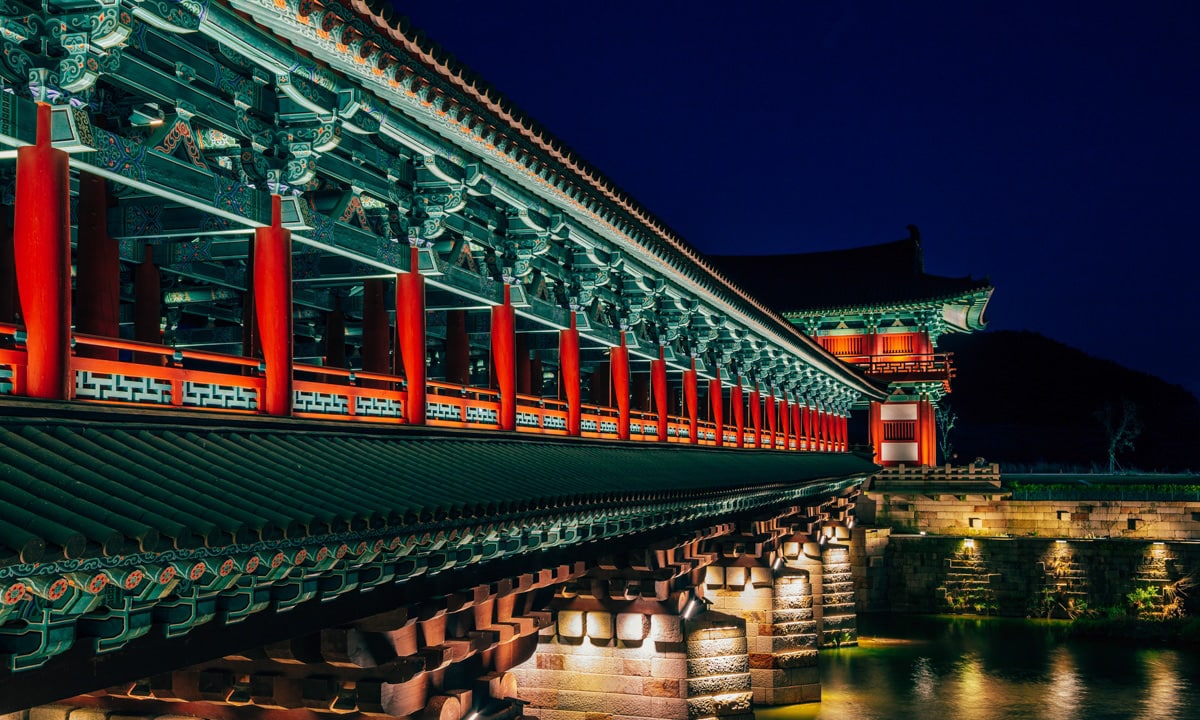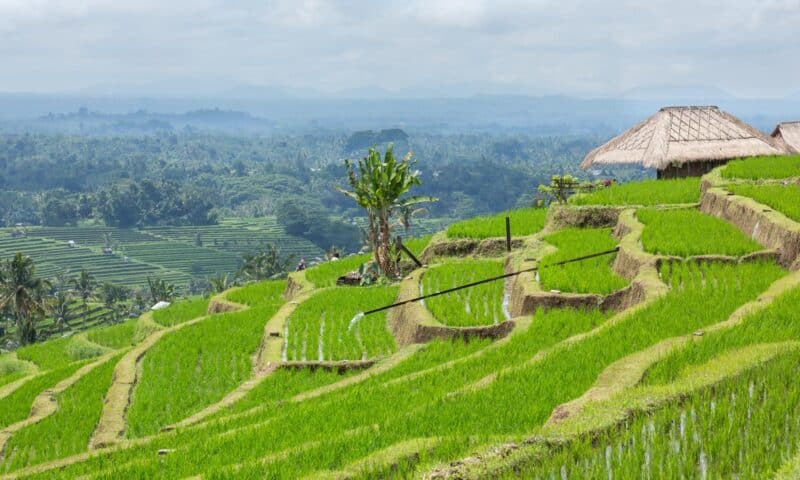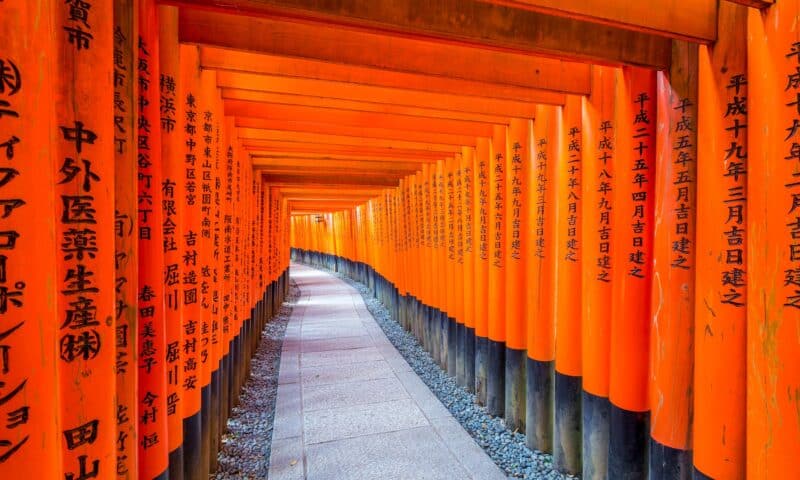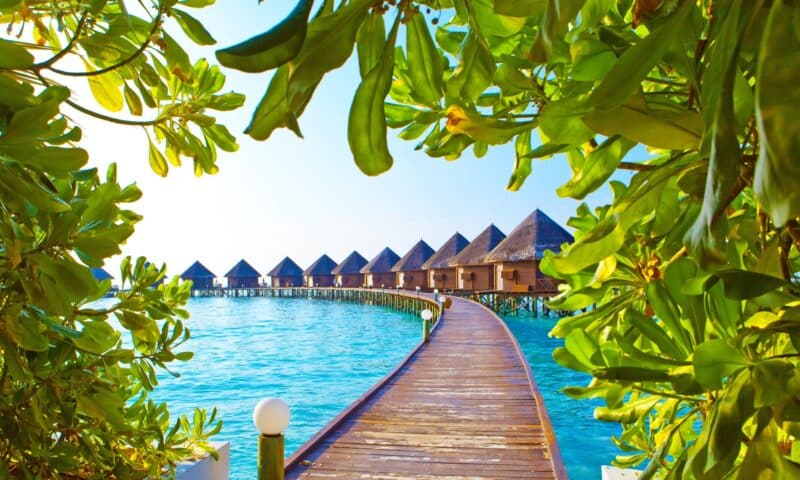While many travelers to South Korea make a beeline for the cosmopolitan pleasures of Seoul, those seeking a more immersive cultural experience would be remiss to overlook the ancient city of Gyeongju. Once the capital of the mighty Silla kingdom (pronounced Shilla), this historic locale offers you an unparalleled window into Korea’s rich history and heritage.
When you visit South Korea, most of the ancient architecture is from the Joseon dynasty period (1392-1897). But did you know that long before the Joseon dynasty, the mighty Silla dynasty reigned supreme for nearly 1,000 years in the city of Gyeongju?
I’ve visited the “museum without walls” twice during my time in South Korea, and even with two visits to this amazing city, it was impossible to see it all. With so many incredible experiences to choose from, where do you start?
Don’t fret – I’ve curated a list of the 15 absolute best things to do in Gyeongju, ensuring you make the most of your time in this captivating corner of the world. From ancient tombs to relic-littered hiking trails, get ready to embark on the ultimate adventure in the Kingdom of Gold!
Disclaimer: This post may contain affiliate links. If you make a purchase or booking through one of our links we may earn a small commission (don’t worry, it’s at no extra cost to you).
The Top 15 Things to Do in Gyeongju, South Korea
1. Cycle Through the Gyeongju Historical Area
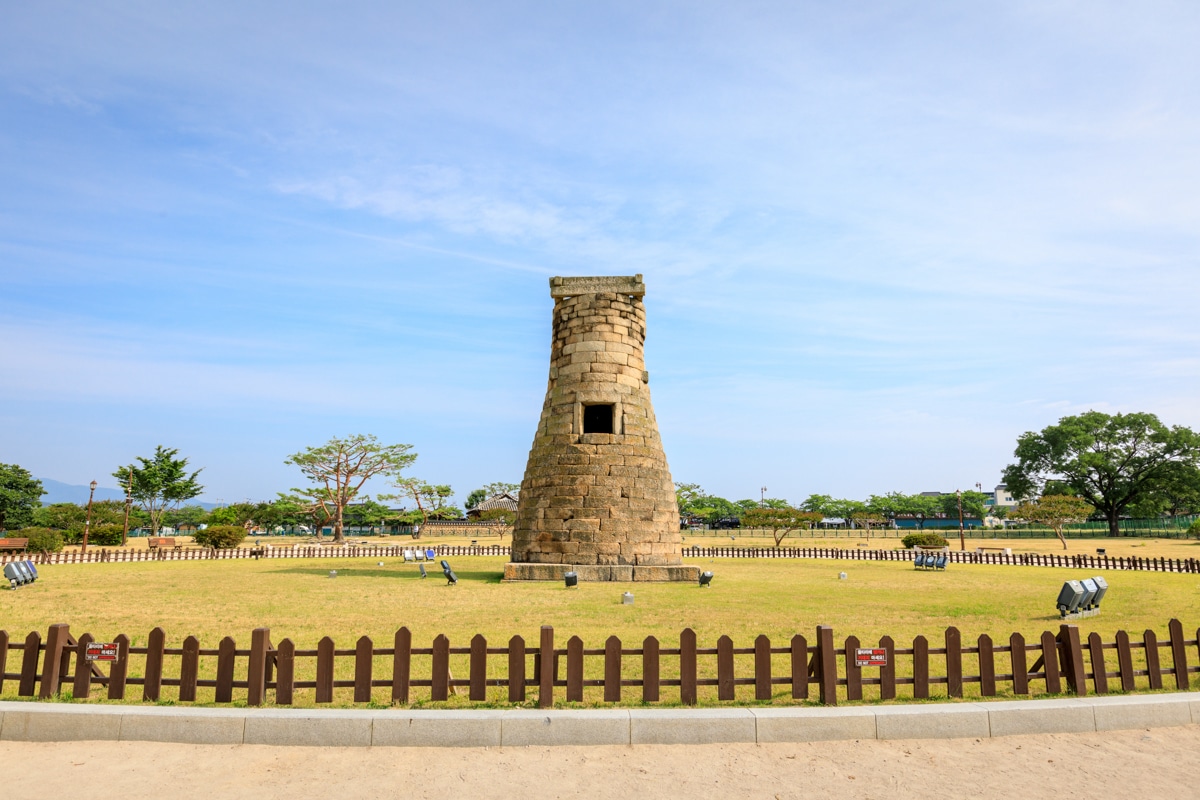
Discovering the cultural wonders of Gyeongju is effortless, with nine out of the 15 best things to do in Gyeongju accessible within the Historical Area! For a truly immersive experience, I highly recommend renting a bike and embarking on a leisurely journey through Gyeongju’s Historical Area, allowing you to explore its rich heritage at your own pace.
Pedaling through this storied landscape, you’ll pass unusual rolling hills – tumulus, the ancient burial tombs of Silla royalty and aristocracy, the largest belonging to kings and queens.
You can make this an all-day adventure, as the sites don’t shut down at night. Wake up early to explore the beautiful outdoors, then during midday, visit a museum or a cafe to escape the heat. As the sun sets, the entire Historical Area is illuminated, casting a magical ambiance over its ancient structures and landscapes.
2. Explore the Secrets of Cheomseongdae Observatory
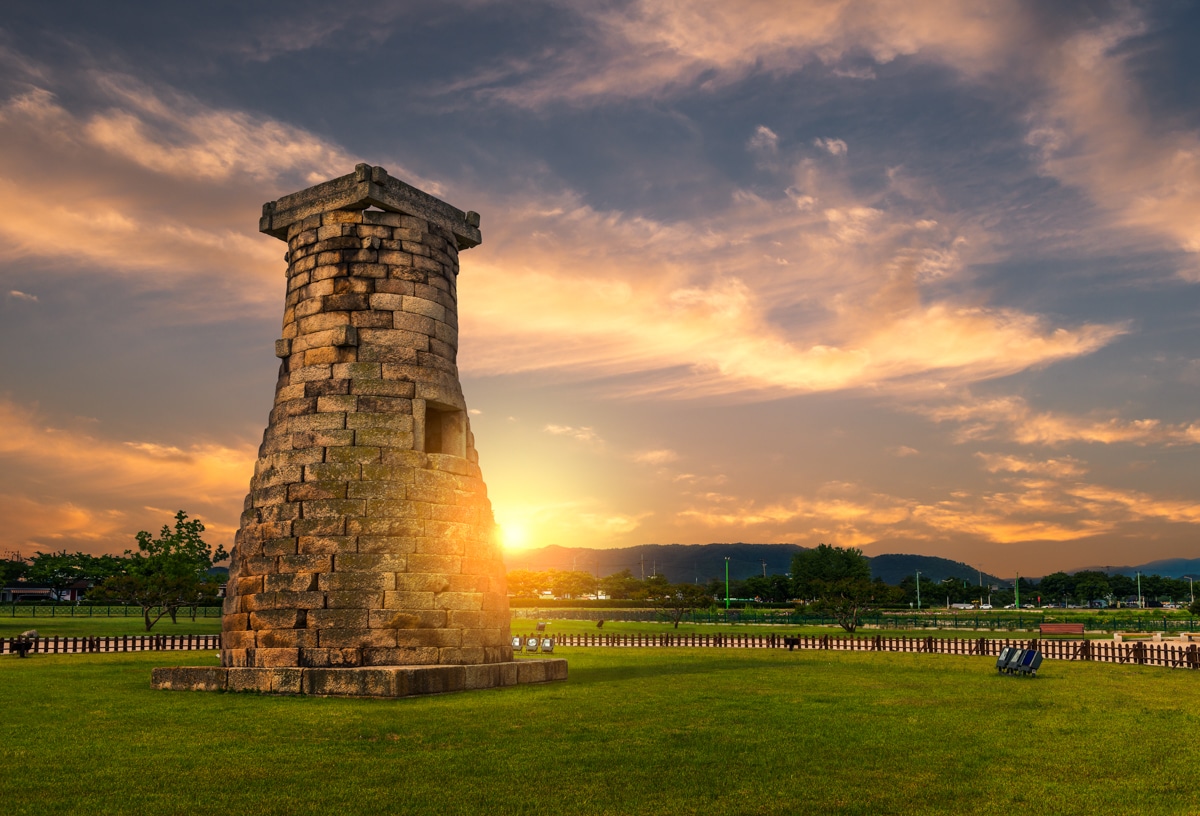
One of the most unique Gyeongju attractions, Cheomseongdae Observatory, Asia’s oldest surviving astronomical observatory, invites visitors to explore the cosmos. It was constructed in the 7th century from 365 curved or bent rectangular stones, each one meticulously arranged to symbolize the passage of days in a year.
Designated a UNESCO World Heritage Site, Cheomseongdae stands as a testament to human ingenuity and scientific curiosity, its appearance remaining unchanged for over 1,300 years. Cheomseongdae is located within a spacious park between vibrant green monsoon-kissed Royal tombs and a sea-like flower field.
The colorful seasonal blooms attract selfie aficionados and novices alike, resulting in teeming crowds. Yet, if you venture there at sunrise, during the magic hour, you may find space for spectacular photographs!
3. Visit Donggung Palace and Wolji Pond (Anapji Pond)
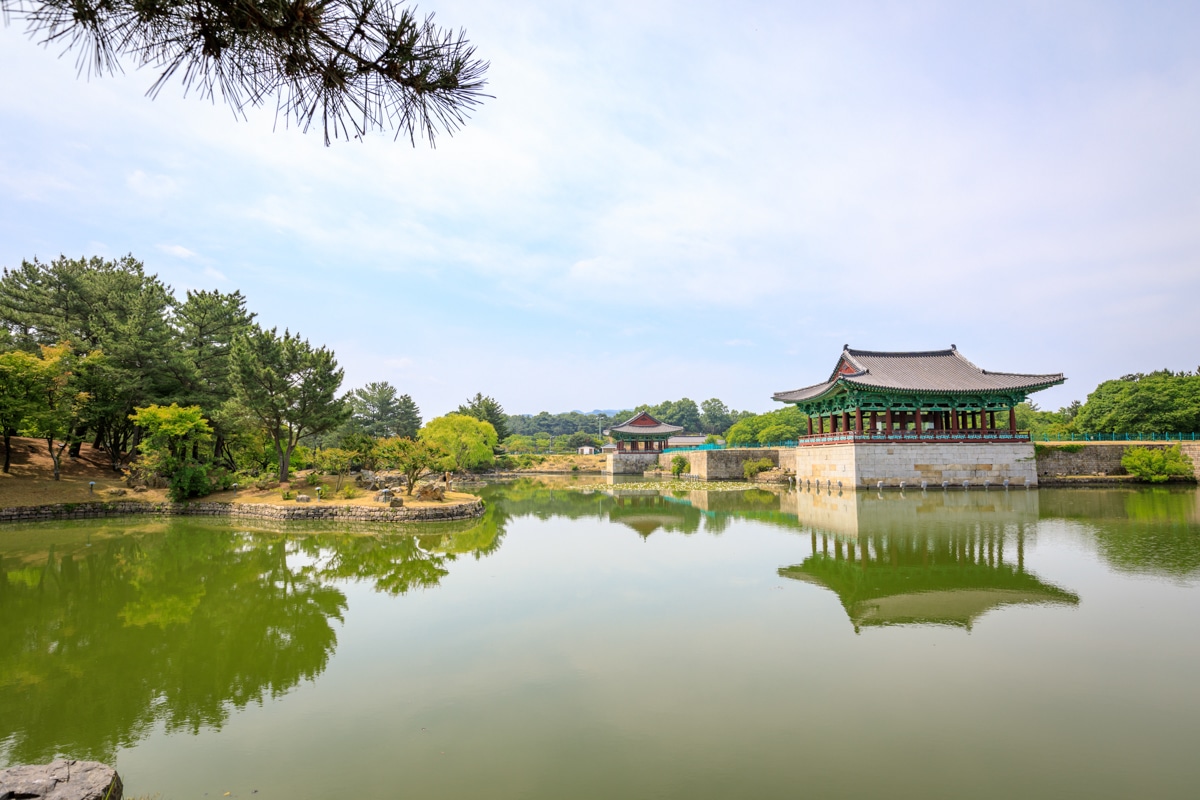
After visiting Cheomseongdae, ride or walk to Donggung Palace and Wolji Pond. This complex is one of the top historical Gyeongju attractions, as it has witnessed centuries of cultural richness. Built in 679 AD to host grand festivals and events, this site holds a significant place in Korean history and heritage.
Initially constructed as a venue for royal gatherings, the palace once boasted a magnificent residence for a prince, adding to its regal allure. Surrounding the placid waters of the pond – which was meticulously crafted in 674 AD – imported exotic animals once roamed the grounds freely, adding to the splendor of the landscape.
You can stroll through the complex year-round, immersing yourself in its timeless beauty, while the lotus fields flanking the Donggung compound offer a peaceful retreat. Timing is everything when it comes to lotus fields since, in the off-season, you will only see fields of mud. So, if you want to enjoy the beautiful lotus flowers, you must visit in the summer months.
With its rich history and breathtaking vistas, Donggung Palace and Wolji Pond Complex stand as a testament to Korea’s enduring cultural legacy.
4. Get a History Lesson at Gyeongju National Museum
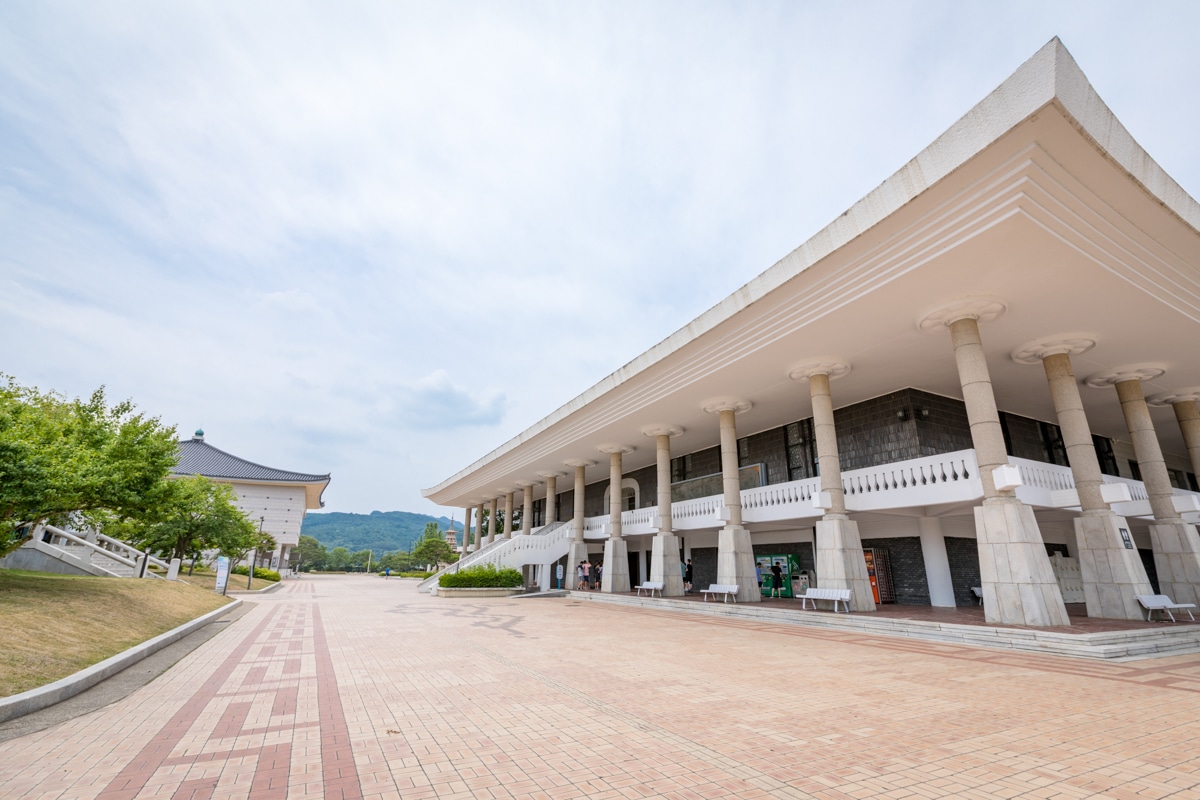
A must on any Gyeongju bucket list, the Gyeongju National Museum has been dedicated to preserving and showcasing the artifacts and treasures of this illustrious era since its opening in 1975. Among the prized possessions is the sacred Bell of Great King Seongdeok, renowned as the largest bell in Korea and revered for its historical and spiritual significance.
You will marvel at the exquisite beauty of the gold crowns, a hallmark of Silla craftsmanship, and understand why they call Gyeongju the Kingdom of Gold. Also called the Kingdom of Buddhism, you will find masterpieces dating back to the 7th and 8th centuries, showcasing the profound influence of Buddhism on Silla culture.
There are three permanent exhibition galleries that highlight the grandeur of the Silla dynasty. The Wolji gallery, in particular, pays homage to the relics unearthed during the draining and excavation of the Wolji Pond.
5. Beat the Heat on the Woljeonggyo Bridge
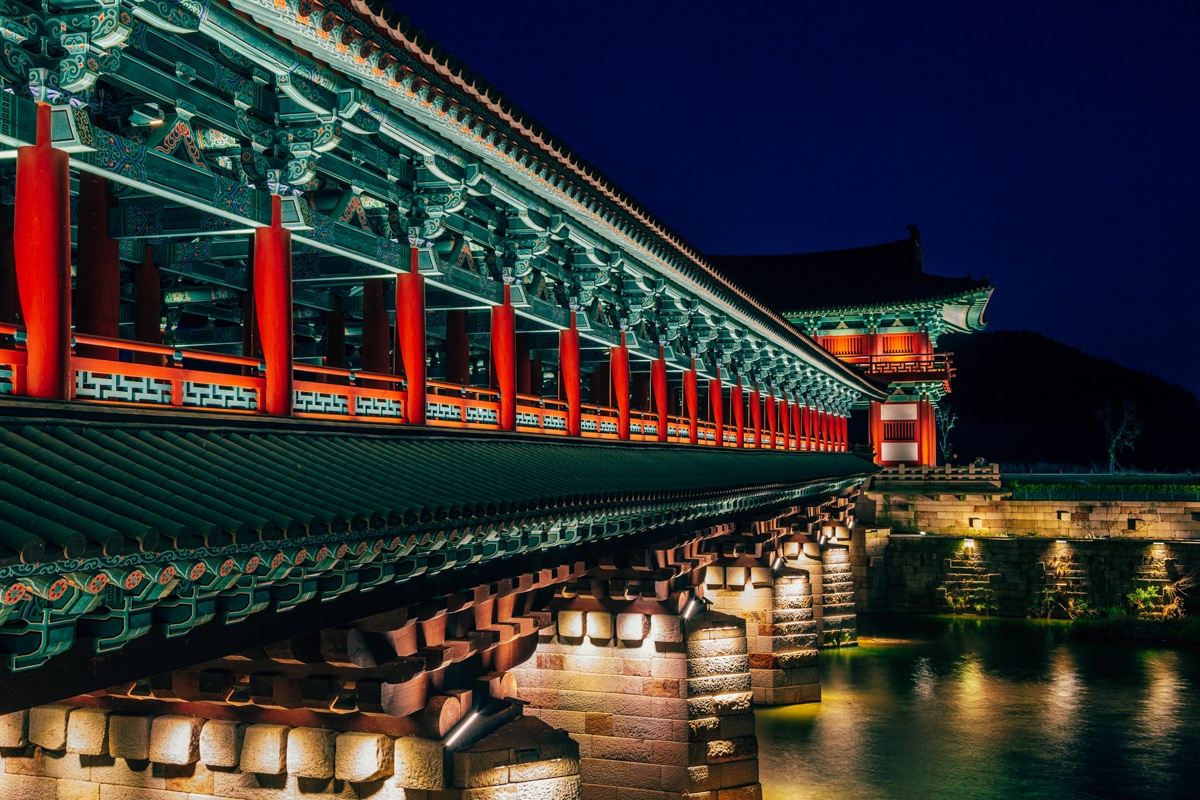
The Woljeonggyo Bridge was built in the year 760 AD during the Silla dynasty. Its construction served a dual purpose: to connect Namsan Mountain to the royal palaces and to span the Nakdongang River.
Today, visitors flock to the bridge not only for its historical significance but also for the serene respite it offers. If you’re looking for things to do in Gyeongju on scorching days, the bridge provides a welcome refuge, offering shade and serving as a refreshing wind tunnel, providing a cool breeze. As dusk descends, the bridge transforms into a brilliant landmark, its shining structure casting a glowing reflection over the flowing river.
The adjacent park offers a tranquil setting for relaxation, while across the river lies the charming Gyochon Traditional Village, offering an opportunity to experience traditional Korean culture.
6. Make Kimchi in Gyochon Hanok Village
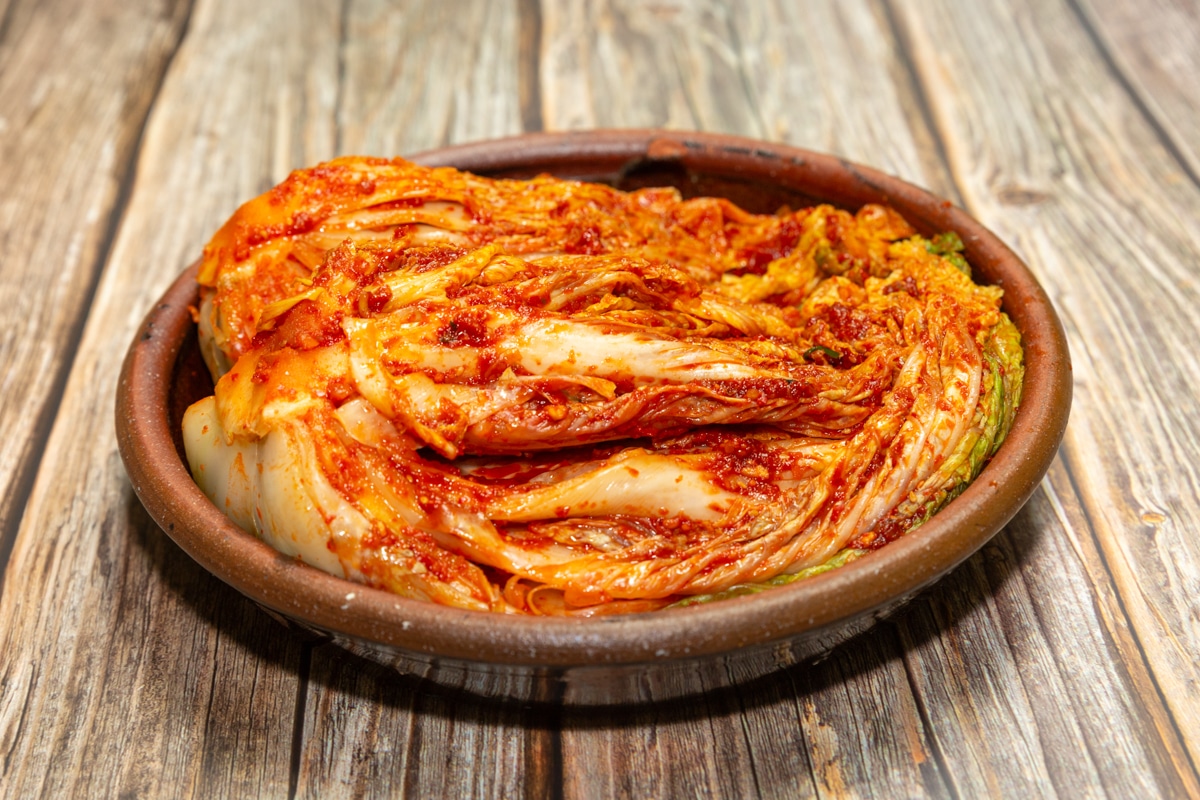
As one of the oldest settlements in Gyeongju, Gyochon Hanok Village offers a taste of Korea’s rich heritage with workshops and educational centers allowing visitors to delve deeper into traditional practices.
There are many hands-on activities like noodle-making and the art of kimchi-making or observing the meticulous process of rice cake preparation – there’s no shortage of opportunities to engage with Korean culture firsthand!
The village is also home to the Gyeongjuhyanggyo Confucian school and the diligently preserved Choe’s Old House. You can also unwind at one of the village’s charming cafes and restaurants, savoring traditional Korean cuisine among the historic surroundings.
7. Stroll Through the Gyerim Forest
Stroll, ride, or simply walk your bike through the tranquil Gyerim forest. As you leisurely wander through this 2,000-year-old forest, you’ll find yourself stepping back in time to an era when it served as a royal hunting ground belonging to Kim Al-ji of the Gyeongju clan.
Legend has it that Kim Al-ji, the founder of the Kim clan, was discovered in this very forest, snuggled within a golden box alongside a rooster, before being adopted by the royal family. Hence, the forest earned its name, Gyerim, meaning “rooster forest.”
Today, the Gyerim forest beckons visitors with its dense canopy of ancient trees of oak, ash, scarlet maple, and many other species. While not as expansive as it once was, the forest still retains its enchanting allure.
8. See Royal Tombs at Daereungwon
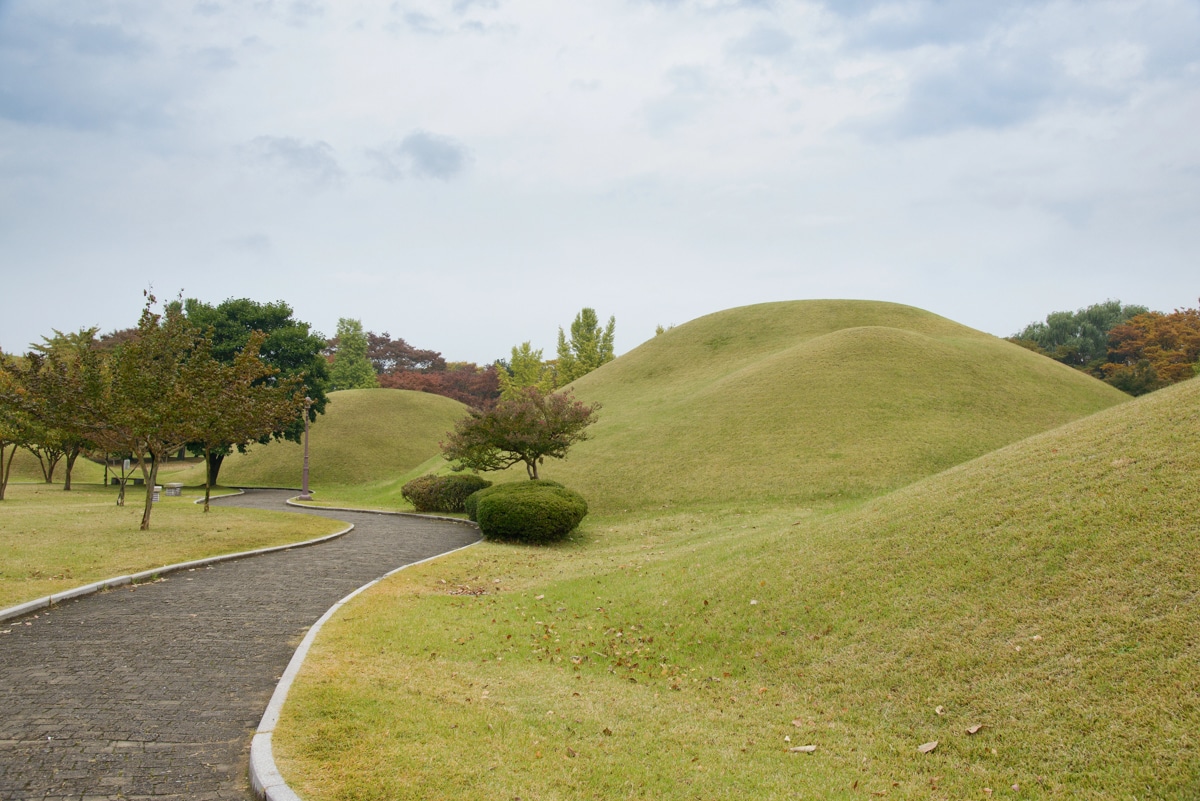
One of the most prominent highlights of Daereungwon is the tomb of King Michu, the first king from the Kim Clan, whose reign spanned from 261 to 284 AD. This tomb stands apart, surrounded by a protective wall. Nearby, a beautiful pond adds to the surprisingly pleasant ambiance, causing you to forget that you are in an ancient graveyard!
In addition to King Michu’s tomb, Daereungwon is home to 23 other royal tombs. As you wander through Tumuli Park, named after the tumulus burial mounds, you’ll find yourself surrounded by these ancient structures, which were built between the late 4th and 6th centuries.
Among the tombs, the Hwangnam Daechong twin mounds stand out, serving as the final resting place of a king and a queen, their legacies intertwined for eternity. Don’t be surprised to see a long line of people waiting to take a photo between the two tombs.
9. Go Inside of Cheonmachong Ancient Tomb
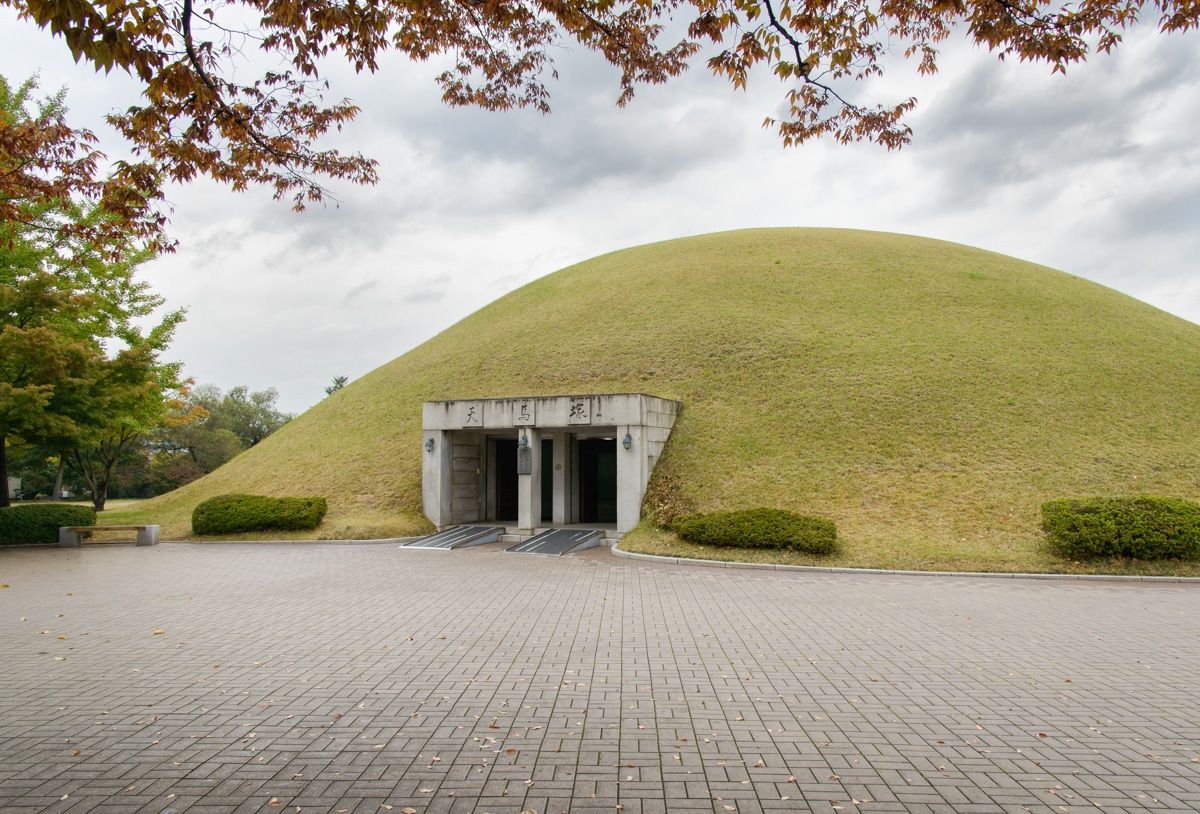
Inside the gates of Daereungwon you will find Cheonmachong Ancient Tomb. This tomb, excavated in 1973, holds a treasure trove of archaeological wonders, offering you a unique opportunity to peer into the ancient burial customs of the Silla dynasty.
Inside Cheonmachong, you can view the unearthed relics that shed light on the lives and customs of the royal Silla people. Among the remarkable discoveries are 11,526 artifacts, including the famed Cheonmad painting – a depiction of a mounted flying horse with eight legs, which is the only painting ever found from the Silla period and the first artwork excavated from an ancient tomb in Korea.
10. Eat, Shop, and Say ‘Cheese’ along Hwanglidangil Road
Hwanglidangil Road is lined with a diverse selection of great restaurants where you can experience Korean and international cuisine. From cozy eateries serving up cold noodles, known as milmyeon, to bakeries offering hwangnambbang red bean pastries and refreshing corn ice cream, there’s something to satisfy every palate.
You’ll discover a myriad of quaint shops offering unique treasures and souvenirs to take home. Capture your visit to Gyeongju in one of the ubiquitous photo booth shops that dot the street. Then take a moment to indulge in coffee and dessert at one of the cute cafes, where you can relax and soak in the ambiance of this vibrant neighborhood.
The buildings themselves are a sight to behold, all constructed in the traditional Hanok style, adding to the area’s charm and authenticity. Be prepared for crowds, as Hwanglidangil can get quite busy!
11. Travel North to Yangdong Folk Village
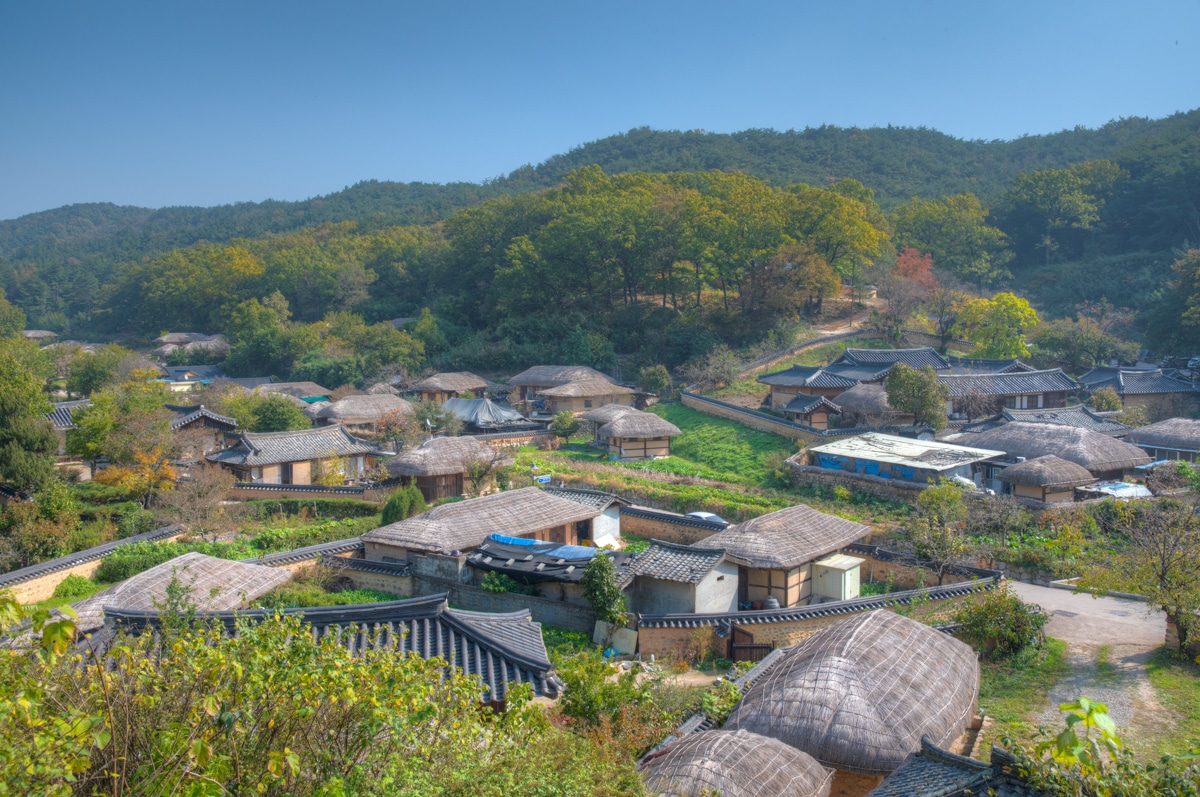
Yangdong Folk Village is renowned for its stunning natural surroundings, with beautiful lotus fields. The village was scrupulously planned to be in harmony with its environment, following the tradition of Korean geomancy, with a majestic mountain backdrop and a tranquil river flowing in the front.
Dating back to the Joseon dynasty, Yangdong is the largest traditional village in the country and has been recognized by UNESCO as a World Heritage Site. Its thatched roof homes, a rarity in South Korea, offer a visit to a bygone era, where simplicity and tradition reigned supreme.
One of the most interesting aspects of the village is its social structure, which is evident in the layout of the homes. The higher-class families reside on the hills, with the height of the hill symbolizing their social status. The yangban, or nobles, have tiled roofs, while the lower classes have thatched roofs, reflecting the Joseon dynasty’s rigid aristocratic class system.
12. Hike Tohamsan Mountain
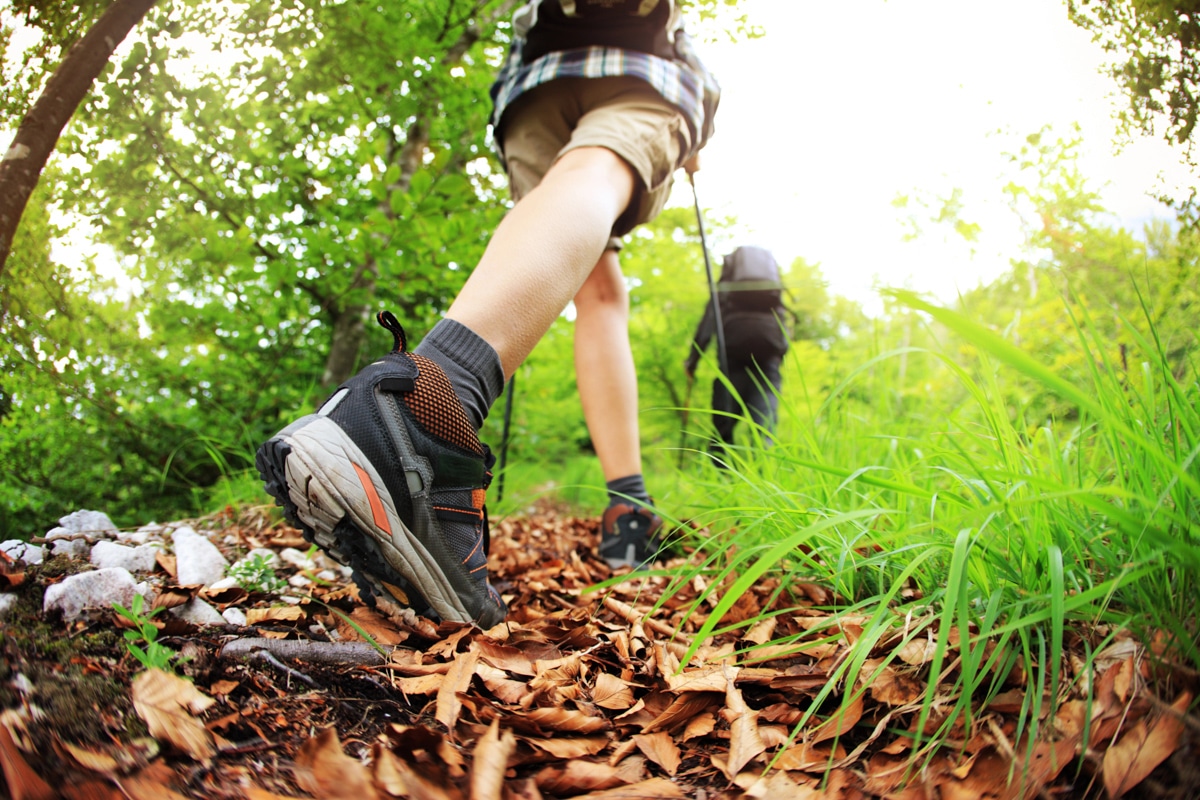
As South Korea’s only historic national park, Gyeongju National Park offers countless natural wonders and cultural treasures for you to explore. Tohamsan Mountain, a majestic peak standing tall at 745 meters above sea level, is one of eight distinct districts within Gyeongju National Park. Unless you plan to visit Gyeongju for longer than a week it is impossible to see the entire park.
I recommend hiking Tohamsan as it is easily accessible and beautiful. It is also the mountain where you can visit all three of my final recommendations for your Gyeongju bucket list!
While Tohamsan is a natural highlight of the park, there’s much more to discover within its eight distinct districts. Namsan Mountain, though not as high as Tohamsan, boasts its own gifts, including 109 temple sites, 36 Buddhist statues, and 13 pagodas.
Gyeongju National Park is also a sanctuary for wildlife, with 25 endangered species protected within its boundaries. However, be mindful of wild boar when hiking, as they roam freely in the park and can be dangerous, so do not approach them.
13. Do a Temple Stay at Golgulsa Temple

When it comes to unique things to do in Gyeongju, Golgulsa Temple offers an opportunity for spiritual enrichment and cultural immersion through its temple stay program. During your temple stay, you’ll have the opportunity to learn Sunmudo, a form of moving meditation and martial art that’s deeply rooted in traditional Buddhism.
In addition to Sunmudo, depending on your length of stay, you can also participate in other activities during your temple stay, such as archery or horse riding. Whether or not you do a temple stay, one of the highlights of a visit to Golgulsa is the chance to climb a rock to see the carved Buddha, a breathtaking sight that has captivated visitors for centuries.
14. Journey to Seokguram Grotto
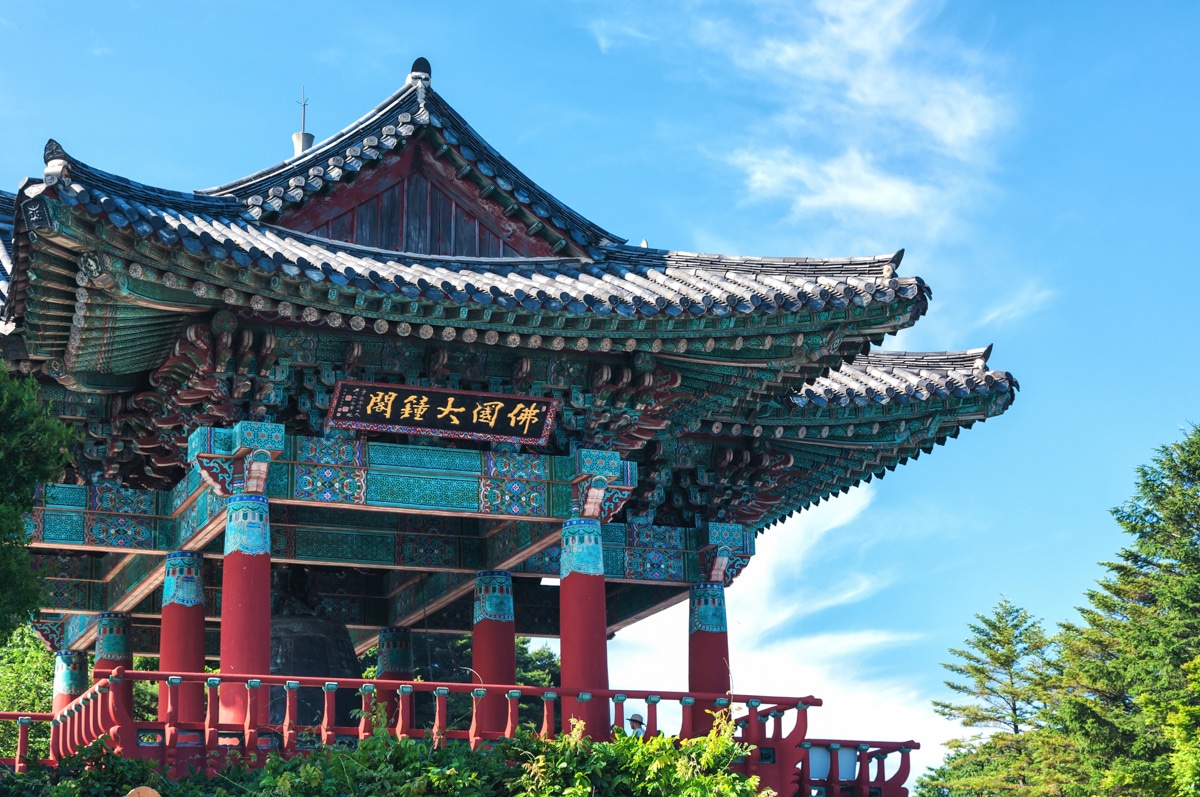
Seokguram Grotto is one of the most iconic and beloved Gyeongju attractions. Cloistered in the mountainside of Tohamsan, this ancient grotto offers visitors a peek into the depth of the Buddhist culture of Korea.
Designated as a UNESCO World Heritage Site, Seokguram holds immense historical and cultural significance, having been built in the 8th century. The grotto is renowned for its stunning Buddha statue, housed behind a glass wall, surrounded by bodhisattvas, arhats, and gods, creating a mesmerizing tableau of spiritual devotion.
Seokguram is intimately linked with Bulguksa Temple, with monks traditionally hiking to the grotto from the temple as part of their spiritual practice. This connection adds to the spiritual significance of the site and underscores its importance in Korean Buddhist tradition.
To fully appreciate the splendor of Seokguram Grotto, it’s advisable to arrive early, as tour buses often bring crowds of visitors later in the day.
15. Experience Ancient Korean Buddhism at Bulguksa Temple
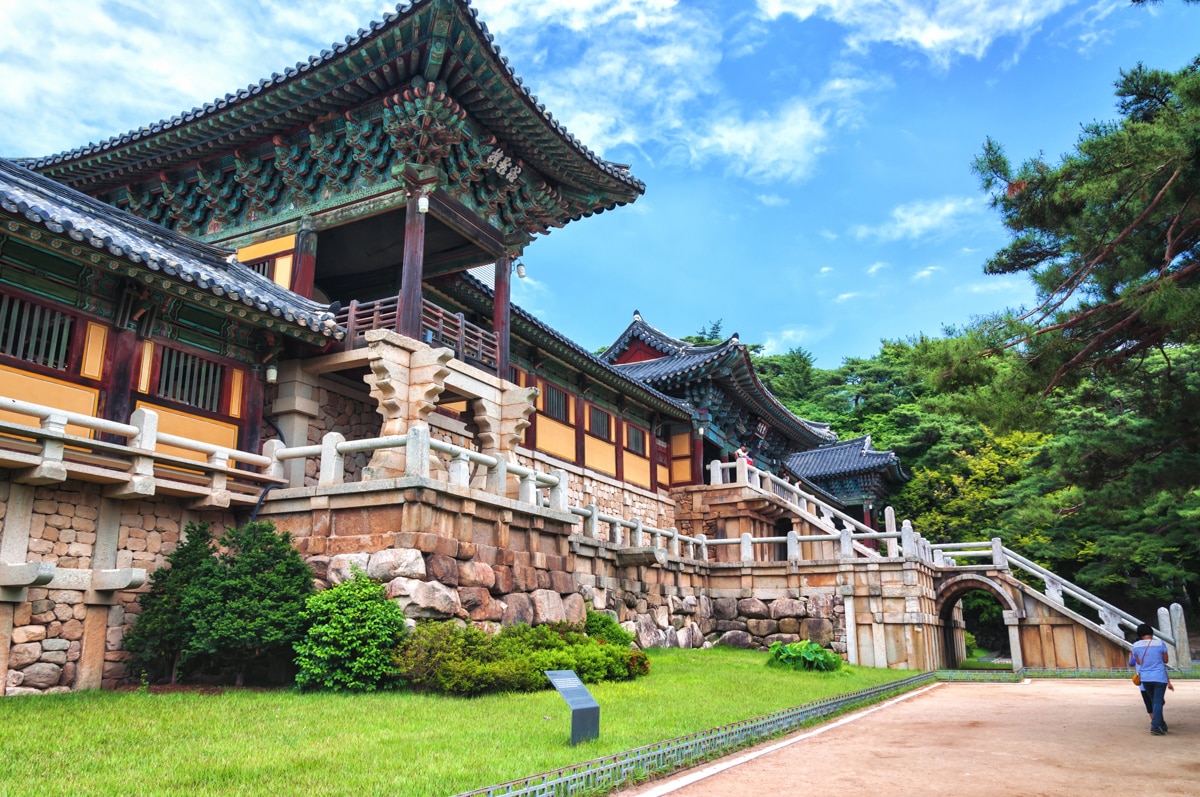
If you only have one day in Gyeongju, Bulguksa Temple is a must-see Gyeongju attraction. Along with Seokguram, Bulguksa Temple is on every list of the best things to do in Gyeongju.
Bulguksa is a testament to the golden age of Buddhist art during the Silla dynasty. You’ll not see another temple like it in Korea. As one of the most iconic and revered temples in the country, Bulguksa holds a special place in the hearts of both locals and visitors alike.
Its exquisite beauty and architectural brilliance have earned it recognition as a UNESCO World Heritage Site and the distinction of containing six national treasures.
While there are many Buddhist temples scattered throughout South Korea, none compare to the unique grandeur and elegance of Bulguksa. It is the only remaining Buddhist temple from the Silla period.
For those looking to explore both Bulguksa and Seokguram, convenient tour buses offer the opportunity to visit both sites in a single trip. However, you have the option to embark on a leisurely hike from Bulguksa to Seokguram, a journey that takes approximately an hour and offers breathtaking views along the way!

